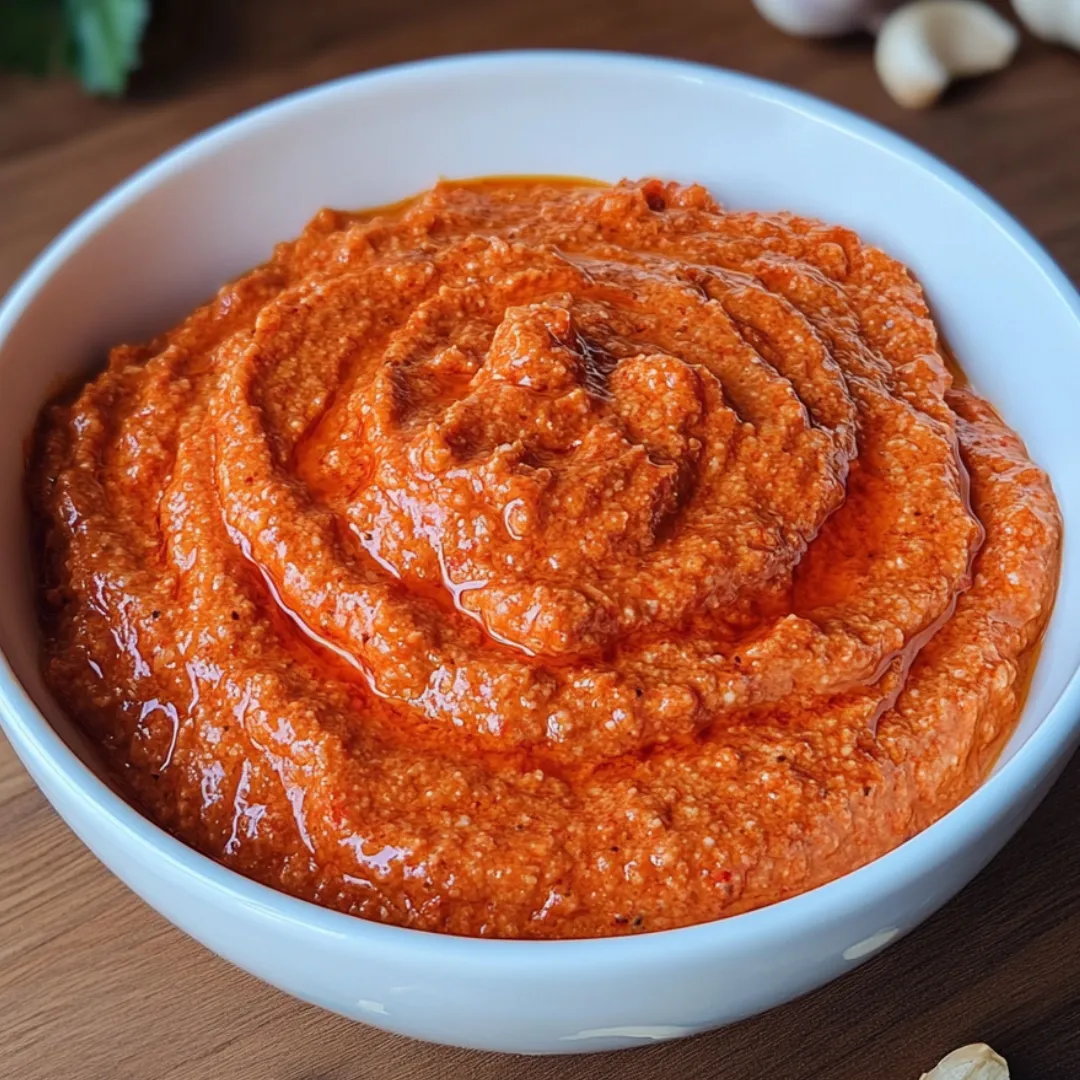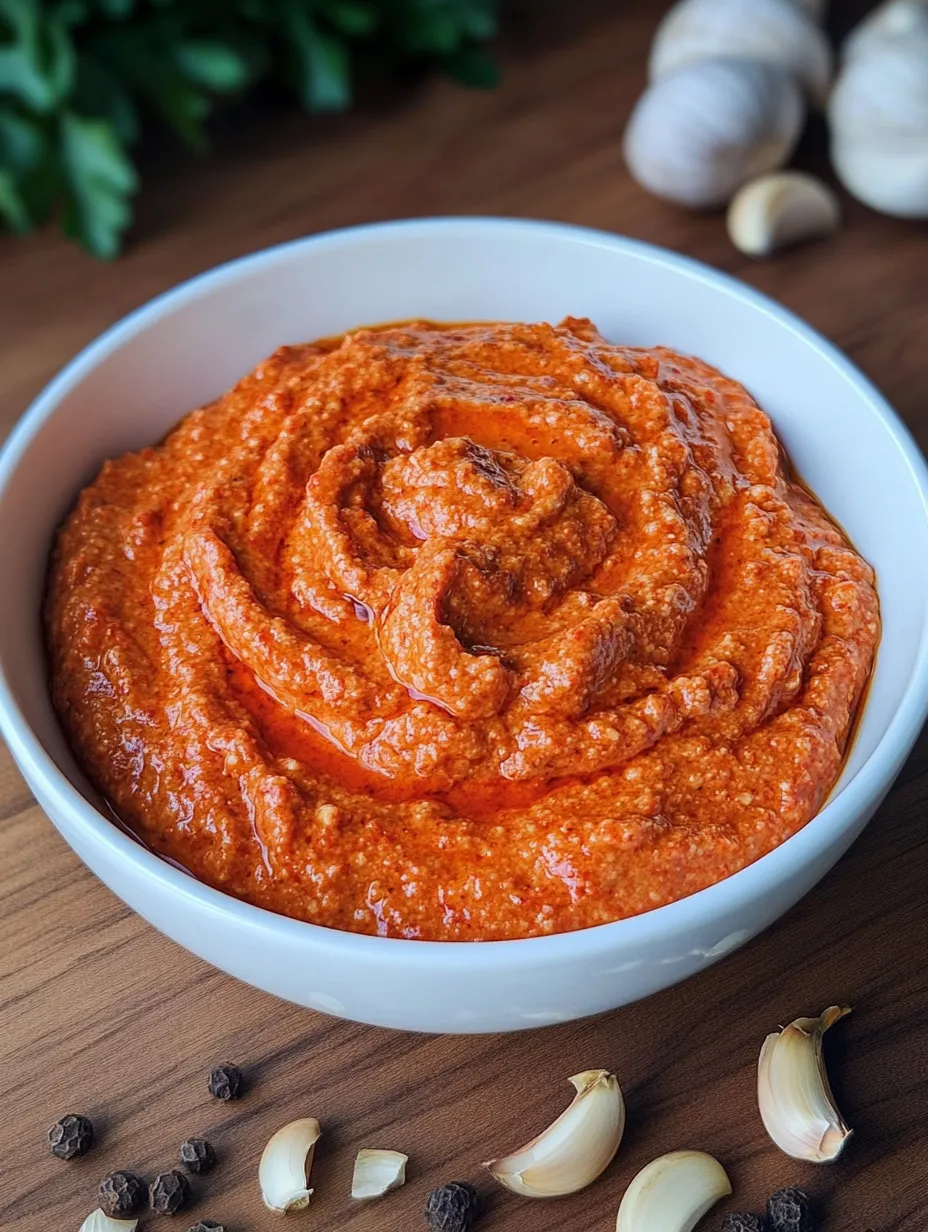 Pin it
Pin it
This vibrant Spanish sauce delivers an explosion of Mediterranean flavors in every spoonful. Rich roasted red peppers, sweet sun-dried tomatoes, and toasted almonds blend together with garlic and paprika to create a versatile condiment that transforms ordinary dishes into memorable meals. Ready in just minutes with your food processor, this simplified version brings authentic Spanish flavor to your kitchen without hunting for specialty ingredients or spending hours cooking.
I first discovered romesco sauce at a Spanish restaurant where it was served with grilled vegetables. The complex flavors completely transformed simple zucchini and eggplant into something extraordinary. When I recreated it at home, my family was amazed at how this simple sauce elevated our weeknight chicken from basic to restaurant-quality. My daughter, who usually avoids vegetables, started requesting "the red sauce" with her broccoli—a parenting victory I attribute entirely to romesco's irresistible flavor.
Ingredients
- Roasted red peppers: Provide sweet, smoky depth as the sauce's foundation. Jarred peppers work perfectly for convenience, though freshly roasted peppers offer even more flavor complexity.
- Sun-dried tomatoes: Add concentrated umami richness that balances the peppers' sweetness. Oil-packed varieties blend more easily and contribute extra flavor through their infused oil.
- Raw almonds: Create body and nutty richness. Unblanched almonds with skins intact offer the most robust flavor, but blanched work well too.
- Fresh garlic: Delivers essential pungency and depth. Fresh cloves provide the most vibrant flavor, but powder can substitute in a pinch.
- Paprika: Contributes earthy sweetness and authentic Spanish character. Regular paprika works well, but smoked paprika (pimentón) adds exceptional depth.
- Vinegar: Balances the richness with necessary acidity. Apple cider vinegar offers fruity notes, but any white vinegar works effectively.
- Olive oil: Binds everything together while adding richness. The flavor is prominent, so choose a quality extra virgin olive oil you enjoy.
 Pin it
Pin it
Instructions
- Step 1:
- Gather your ingredients - Begin by assembling all ingredients to streamline the process. For roasted red peppers, you can use jarred peppers (drained) or roast your own by charring bell peppers under a broiler or over an open flame until blackened on all sides, then steaming them in a covered bowl for 10 minutes before peeling away the skin and removing seeds. The sun-dried tomatoes should be drained if packed in oil, though saving a bit of the flavorful oil to add to the sauce can enhance the final result. For the almonds, raw unblanched provides the most authentic flavor, but you can toast them lightly in a dry pan for 3-4 minutes to intensify their nuttiness. Having everything measured and ready creates a smooth workflow and ensures no ingredients are forgotten.
- Step 2:
- Combine everything in your food processor - Add 2 roasted red peppers, ½ cup almonds, ¼ cup sun-dried tomatoes, 2-3 garlic cloves, 1 teaspoon paprika, 2 tablespoons vinegar, and ¼ cup olive oil to your food processor or high-powered blender. The order isn't critical, but placing harder ingredients like almonds at the bottom near the blades helps achieve a more even texture. Add a pinch of salt to start—you can adjust later after tasting. If you prefer a thinner consistency, add a tablespoon or two of water or additional olive oil. For a spicier version, include a pinch of red pepper flakes or a dash of cayenne. The beauty of this sauce is its flexibility—you can adjust proportions based on your preference or what you have available.
- Step 3:
- Process to desired consistency - Pulse the mixture several times to break down the larger pieces, then process continuously until you reach your preferred texture. Some prefer romesco sauce with a bit of texture and small chunks of almonds for character, while others enjoy a completely smooth consistency. For a chunky version, process for about 30-45 seconds, stopping to scrape down the sides of the bowl as needed. For a smoother sauce, continue processing for 1-2 minutes total. The almonds will determine the texture—they should be broken down enough to thicken the sauce but can remain slightly chunky for authentic character. If the mixture seems too thick, add olive oil one tablespoon at a time until you reach the desired consistency.
- Step 4:
- Taste and adjust seasonings - Once blended, taste your romesco sauce and adjust the seasonings to perfect the flavor balance. Add more salt if needed—start with ¼ teaspoon and adjust upward. If the sauce tastes flat, add a touch more vinegar for acidity. For deeper flavor, incorporate another clove of garlic or an extra dash of paprika. If you want more richness, drizzle in additional olive oil while the processor runs. The sauce should have a harmonious balance of nutty, sweet, tangy, and savory notes. Once perfectly seasoned, transfer to a serving bowl if using immediately, or store in an airtight container in the refrigerator where it will keep for up to a week. The flavors actually improve after a few hours as they meld together.
I discovered the importance of properly processing the almonds after my first attempt left the sauce too gritty. Now I either soak them as mentioned or lightly toast them first, which softens their texture while deepening the flavor. Another game-changer was learning to add the oil gradually rather than all at once—this creates a more emulsified sauce with better texture, similar to making mayonnaise. When I have extra time, I also like to roast my own peppers rather than using jarred ones—the fresh roasted flavor adds a noticeable depth that makes the sauce even more special.
Serving Suggestions
The versatility of romesco sauce is truly its superpower. Traditionally served with grilled or roasted vegetables, it transforms even the simplest produce into a memorable dish. Try it with roasted asparagus, cauliflower steaks, or Brussels sprouts for an elevated side dish.
For protein pairings, romesco complements both bold and mild flavors. Spoon it over grilled chicken, roasted fish like cod or salmon, or use it to brighten up simply prepared steak or lamb. The sauce adds both flavor and visual appeal to plates that might otherwise look monotone.
Perhaps my favorite way to enjoy romesco is as part of a grazing board. Serve it in a small bowl surrounded by crusty bread, roasted vegetables, marinated olives, and Spanish cheeses like Manchego. It creates an instant tapas experience that's perfect for casual entertaining.
 Pin it
Pin it
Make-Ahead and Storage Tips
Romesco sauce actually improves with time as the flavors meld together, making it perfect for meal prep. After preparing, transfer to an airtight container and refrigerate for up to one week. A thin layer of olive oil on the surface helps preserve freshness and prevent discoloration.
For longer storage, romesco freezes beautifully. Portion it into ice cube trays, freeze until solid, then transfer the cubes to a freezer bag. This method creates perfect single-serving portions that thaw quickly when needed. Frozen romesco maintains quality for up to three months.
When using refrigerated sauce, let it come to room temperature before serving for the fullest flavor. If the sauce has thickened during storage, simply stir in a small amount of olive oil or water to reach the desired consistency.
After making this sauce dozens of times, I've found that toasting the almonds until golden before blending adds remarkable depth to the final sauce. I also discovered that using the oil from the sun-dried tomatoes (if using oil-packed) instead of plain olive oil incorporates additional flavor compounds that make the sauce even more complex and interesting. When serving with vegetables that need a flavor boost, I like to finish both the vegetables and the sauce with a light sprinkle of flaky sea salt—this final touch highlights the natural flavors and creates contrast in each bite.
Frequently Asked Questions
- → What dishes pair well with Romesco sauce?
- Romesco sauce is incredibly versatile! It's traditionally served with grilled vegetables, fish (especially cod), chicken, or as a spread on toasted bread. It also works as a dip for raw vegetables or a sauce for pasta.
- → How long does homemade Romesco sauce last?
- When stored in an airtight container in the refrigerator, this sauce will keep well for up to 1 week. The flavors actually improve after a day as they meld together.
- → Can I substitute the almonds with other nuts?
- Yes! Traditional Romesco sometimes uses hazelnuts instead of or in addition to almonds. Walnuts can also work well as a substitute.
- → Is Romesco sauce spicy?
- This recipe has a mild heat from the chipotle. You can adjust the spice level by increasing or decreasing the amount of chipotle, or substituting with smoked paprika for a milder version.
- → Can I freeze Romesco sauce?
- Yes, Romesco sauce freezes well for up to 3 months. Freeze in small portions or ice cube trays for convenient use. Thaw in the refrigerator and stir well before using.
